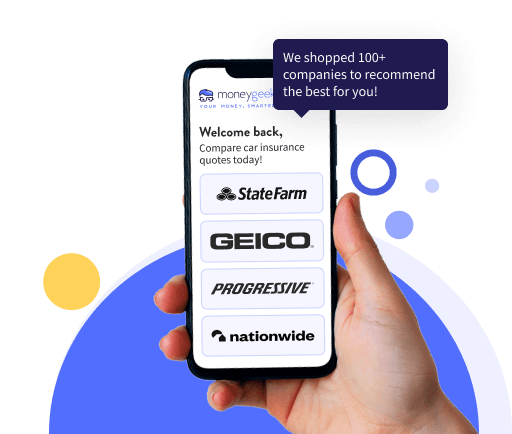Compare the Cheapest or Best Car Insurance for You
MoneyGeek analyzed millions of car insurance quotes to find the cheapest and best car insurance companies across all coverage levels. No car insurance company is the cheapest for every driver, but some companies are more affordable than others. Compare car insurance quotes and companies below.
The cheapest insurance policy might not always be the best fit for you. The top car insurance companies balance affordability and service, and if you're a homeowner, you may consider bundling multiple insurance policies together.
Car Insurance Calculator
MoneyGeek's car insurance calculator will give you a customized estimate of your auto insurance cost. It's free to use, requires no personal information and we won't send you any spam.
Rates updated:
Jul 14, 2025
| Insurance Carrier | MoneyGeek ScoreMG Score | Average Monthly Payment | |
|---|---|---|---|
| 1 |  Capital Insurance Group | 94 /of 100 | $87 |
| 2 |  GEICO | 82 /of 100 | $109 |
| 3 | 83 /of 100 | $118 | |
| 4 | 83 /of 100 | $129 | |
| 5 | 79 /of 100 | $133 | |
| 6 | 77 /of 100 | $151 |
Although MoneyGeek partners with some of the companies we recommend, our content is written and reviewed by an independent team of writers, editors and licensed agents. Learn more about our editorial policies and expert editorial team.
Compare Car Insurance Rates by State
Your location plays a major role in what you'll pay for car insurance. Insurance rates vary significantly from state to state because of different laws, required coverage levels, and local risk factors like accident rates, theft, and weather patterns. Some states require drivers to carry more extensive coverage, which drives up costs, while others have more basic requirements that can keep premiums lower.
| Alabama | $ 1,002 | $ 84 |
| Alaska | $ 1,122 | $ 94 |
| Arizona | $ 1,553 | $ 129 |
| Arkansas | $ 1,333 | $ 111 |
| California | $ 1,608 | $ 134 |
| Colorado | $ 1,487 | $ 124 |
| Connecticut | $ 1,961 | $ 163 |
| Delaware | $ 2,163 | $ 180 |
| District of Columbia | $ 1,685 | $ 140 |
| Florida | $ 2,211 | $ 184 |
| Georgia | $ 1,484 | $ 124 |
| Hawaii | $ 890 | $ 74 |
| Idaho | $ 861 | $ 72 |
| Illinois | $ 1,174 | $ 98 |
| Indiana | $ 877 | $ 73 |
| Iowa | $ 1,077 | $ 90 |
| Kansas | $ 1,389 | $ 116 |
| Kentucky | $ 1,297 | $ 108 |
| Louisiana | $ 2,333 | $ 194 |
| Maine | $ 961 | $ 80 |
| Maryland | $ 1,577 | $ 131 |
| Massachusetts | $ 1,193 | $ 99 |
| Michigan | $ 1,905 | $ 159 |
| Minnesota | $ 1,295 | $ 108 |
| Mississippi | $ 1,172 | $ 98 |
| Missouri | $ 1,491 | $ 124 |
| Montana | $ 1,183 | $ 99 |
| Nebraska | $ 1,244 | $ 104 |
| Nevada | $ 1,985 | $ 165 |
| New Hampshire | $ 781 | $ 65 |
| New Jersey | $ 1,943 | $ 162 |
| New Mexico | $ 1,217 | $ 101 |
| New York | $ 2,620 | $ 218 |
| North Carolina | $ 1,178 | $ 98 |
| North Dakota | $ 969 | $ 81 |
| Ohio | $ 828 | $ 69 |
| Oklahoma | $ 1,175 | $ 98 |
| Oregon | $ 1,386 | $ 116 |
| Pennsylvania | $ 1,350 | $ 113 |
| Rhode Island | $ 1,443 | $ 120 |
| South Carolina | $ 1,899 | $ 158 |
| South Dakota | $ 1,236 | $ 103 |
| Tennessee | $ 1,137 | $ 95 |
| Texas | $ 1,702 | $ 142 |
| Utah | $ 1,233 | $ 103 |
| Vermont | $ 832 | $ 69 |
| Virginia | $ 1,159 | $ 97 |
| Washington | $ 1,387 | $ 116 |
| West Virginia | $ 1,375 | $ 115 |
| Wisconsin | $ 1,094 | $ 91 |
| Wyoming | $ 908 | $ 76 |
Compare Car Insurance By Car Make & Model
The car model you choose can make a big impact on your car insurance rates. Generally, the more a vehicle costs to purchase, the more expensive it is to insure. Insurers also consider factors like your car's safety ratings, theft rates, repair costs, and available safety features when determining your insurance premium. Newer cars, sports cars and electric vehicles also tend to have higher-than-average insurance prices. Click below to compare car insurance costs for different makes and models.
Why Compare Car Insurance?
Car insurance rates vary widely between providers, even for the same driver. The only way to ensure you're getting the best price is to compare multiple quotes. At MoneyGeek, we make this process simple. Our tools allow you to quickly see real rates for your driver profile, helping you find the most affordable option. By comparing quotes with MoneyGeek, you can confidently choose an insurer that fits your budget and provides the protection you need.
Why Trust MoneyGeek? MoneyGeek conducted an analysis and gathered data from Quadrant Information Services and state insurance departments using various profiles and geographic locations to showcase how critical it is to compare car insurance rates when shopping for a policy — as rates for the same individual profile can differ greatly across insurance companies.
How to Compare Car Insurance Quotes
To effectively compare car insurance quotes, follow these four steps: gather your personal information, determine the appropriate coverage levels, apply all available discounts, and then compare prices.
- 1
Collect your vehicle and personal information
Most information needed for an online quote is straightforward, but companies often require specific details you may not have available, including:
- The Vehicle Identification Number (VIN) as well as the make, model, and year of your car.
- A list of any anti-theft or safety devices installed in your vehicle.
- Your estimated daily commuting mileage or total mileage.
- Information regarding any driving incidents within the past five to ten years, such as speeding tickets or at-fault accidents.
- The name of your current insurance company and the duration of your policy with them.
- Your Social Security number.
- The age at which you first obtained your driver’s license or how long you have held a driver’s license.
- Similar information is needed for any other drivers or vehicles you plan to include in the policy.
- 2
Decide on appropriate coverage levels and keep them consistent
Once you decide how much coverage you wish to purchase, make sure to use the same coverage levels when comparing different insurance companies. This method allows you to compare "apples to apples" and ensures that the rates you receive provide a fair estimate of what each company is offering.
- 3
Apply all relevant discount information
When filling out an online quote form, make sure all applicable discounts are applied to your quote. Different insurance companies offer varying discounts, which can impact the final price. Sometimes, you may need to contact an agent to confirm that all applicable discounts are reflected in your quote.
Regardless of discounts, you should focus on the bottom line. An insurance company may offer discounts, but if its rates are similar to competitors, it won’t make much of a practical difference to you than if you bought a policy with cheap rates and limited deals even after discounts are applied.
- 4
Compare car insurance quotes across companies
We recommend comparing at least three car insurance companies; however, the more insurers you review, the better your chances of finding the best deal. In addition to focusing on savings, it's important to evaluate each insurer’s customer service experience and flexible payment plans and low down payment options. This will help you choose a company that is effective and fair when it comes to handling claims. See our guide to switching car insurance companies.
Compare MoneyGeek's Reviews on National Insurers
There are many factors to consider when shopping for car insurance. Finding a company with affordable rates is a great starting point. Still, other factors like customer satisfaction and the ability to pay claims are essential when using your coverage. See MoneyGeek's review of each car insurance company so you can choose what's right for you.
Compare MoneyGeek's Reviews on Regional Insurers
Sometimes, the best car insurance is a regional company unavailable in all states. MoneyGeek reviewed companies with a smaller coverage footprint to determine whether a smaller insurer is best for your needs.
Compare Factors That Can Impact Auto Insurance Costs
Car insurance rates are not the same for all drivers, they vary based on multiple factors including age, driving history, location, credit score, state regulations, and your car model. By understanding these factors, you can find ways to compare car insurance companies and lower your costs.
- Accident History: If you have been involved in an accident, insurance companies may classify you as a higher risk, which can lead to increased premiums. If this applies to you, view our rankings on the best cheap car insurance after an accident.
- High Risk Drivers: Drivers with multiple infractions or serious violations may be categorized as high-risk. This can result in limited options from insurance providers and higher costs. If you fall into this category, check out our page on the cheapest car insurance for high-risk drivers in 2025.
- DUI Conviction: A DUI can lead to a substantial increase in your insurance rates. Additionally, some states require an SR-22 form to demonstrate that you have the necessary insurance coverage. If you’ve been convicted of a DUI, make sure to view our rankings on the cheapest car insurance after a DUI in 2025 and cheapest SR-22 insurance.
State Laws and Minimum Coverage Requirements:
Your location influences your car insurance rates. Each state has its own minimum coverage requirements; some may even require additional coverage, such as personal injury protection (PIP) or uninsured motorist coverage. Use our guide to determine how much car insurance you need. Generally, states with higher insurance requirements tend to have higher premiums. Read more on this topic on our page about state minimum car insurance requirements.
Driver Age and Gender:
Insurance companies evaluate risk based on factors such as age and gender. Young drivers, particularly teenagers, generally face higher premiums because they lack driving experience. Likewise, male drivers, especially in younger age groups, often pay more than female drivers due to higher statistical accident risks associated with their demographic. See how rates vary in our analysis of average car insurance rates by age and gender.
Driving History:
Your driving record plays a consequential role in determining your insurance rates.
Credit Score:
Many insurers utilize credit-based insurance scores to evaluate risk. A higher credit score can lead to lower premiums, while poor credit may result in higher rates. If you have poor credit, you might find our rankings on the cheapest car Insurance for drivers with bad credit helpful.
Income-Level:
Your income-level does not directly affect insurance rates; however, some states provide programs to assist eligible drivers in affording coverage. Moreover, lower-income drivers may find it challenging to manage high premiums, making it necessary to explore discounts and state-sponsored programs for more affordable options. We crunched the numbers in our guide to cheapest car insurance for low-income drivers.
Non-Vehicle Owner:
If you don’t own a vehicle but still need liability coverage, non-owner car insurance can be a cost-effective option. This type of policy is appropriate for those who frequently rent cars or need coverage to keep their driver's license active. Have a look at our rankings of the best cheap non-owner car insurance in 2025.
Frequently Asked Questions About Comparing Car Insurance
Here are some common questions people have about car insurance. Click on each question to learn more about finding the best coverage for your needs.





















